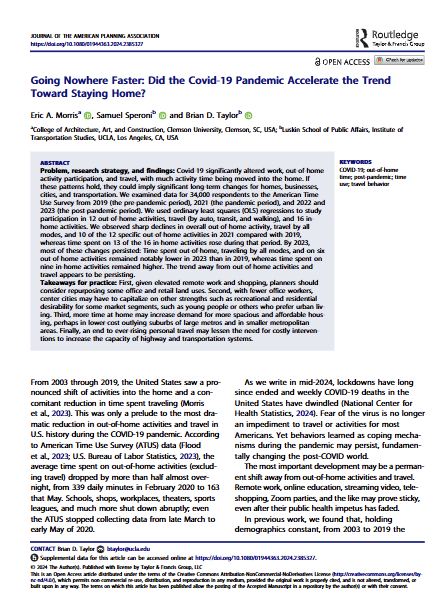Date: October 30, 2024
Author(s): Eric Morris, Samuel Speroni, Brian D. Taylor
Abstract
Problem, research strategy, and findings
Covid-19 significantly altered work, out-of-home activity participation, and travel, with much activity time being moved into the home. If these patterns hold, they could imply significant long-term changes for homes, businesses, cities, and transportation. We examined data for 34,000 respondents to the American Time Use Survey from 2019 (the pre-pandemic period), 2021 (the pandemic period), and 2022 and 2023 (the post-pandemic period). We used ordinary least squares (OLS) regressions to study participation in 12 out-of-home activities, travel (by auto, transit, and walking), and 16 in-home activities. We observed sharp declines in overall out-of-home activity, travel by all modes, and 10 of the 12 specific out-of-home activities in 2021 compared with 2019, whereas time spent on 13 of the 16 in-home activities rose during that period. By 2023, most of these changes persisted: Time spent out-of-home, traveling by all modes, and on six out-of-home activities remained notably lower in 2023 than in 2019, whereas time spent on nine in-home activities remained higher. The trend away from out-of-home activities and travel appears to be persisting.
Takeaways for practice
First, given elevated remote work and shopping, planners should consider repurposing some office and retail land uses. Second, with fewer office workers, center cities may have to capitalize on other strengths such as recreational and residential desirability for some market segments, such as young people or others who prefer urban living. Third, more time at home may increase demand for more spacious and affordable housing, perhaps in lower-cost outlying suburbs of large metros and in smaller metropolitan areas. Finally, an end to ever-rising personal travel may lessen the need for costly interventions to increase the capacity of highway and transportation systems.
About the Project
While many aspects of life have largely returned to pre-pandemic patterns as the COVID-19 pandemic has become endemic, several aspects of travel remain unsettled and uncertain. In particular, the forced experiment of working from home for at least half of the labor force in 2020 is evolving into a new normal where perhaps a third of all workers split their work hours between office and home. This has had especially significant effects on public transit, which has traditionally carried a disproportionate share of commute trips, but these new work patterns have affected the timing and character of many other trips as well. These evolving patterns of travel may call into question many current transportation policies and plans that are premised on (now) outdated ideas about travel.


